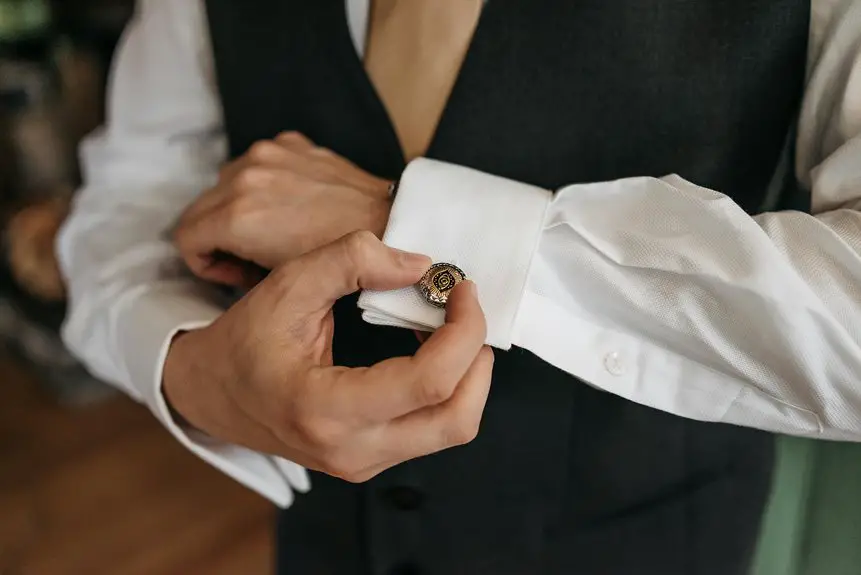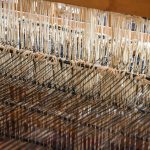You use Kevlar fabric for everything from bulletproof vests to spacecraft parts because it’s incredibly strong yet lightweight. It’s made from a polymer that’s five times stronger than steel by weight and resists heat and cuts, making it perfect for personal protection gear and aerospace structures. Kevlar also improves vehicle safety and industrial products with its impact resistance. If you want to discover how Kevlar is shaping future innovations across these fields, keep exploring the details.
Table of Contents
Key Takeaways
- Kevlar fabric is essential in bulletproof vests, providing lightweight, flexible, and strong ballistic protection against bullets and shrapnel.
- In the automotive industry, Kevlar enhances tire puncture resistance, brake pads, and body panels, improving vehicle safety and durability.
- Aerospace applications use Kevlar to reinforce aircraft and spacecraft components, offering high strength with reduced weight for better fuel efficiency.
- Kevlar’s heat resistance and impact absorption protect spacecraft from debris and contribute to thermal insulation and structural integrity.
- Emerging uses of Kevlar include hybrid fabrics with graphene, advanced wearable tech, and reinforcement materials for safer buildings and medical devices.
Characteristics and Composition of Kevlar Fabric
Although you mightn’t see Kevlar fabric every day, its unique characteristics and composition make it an essential material in many industries.
You’ll find Kevlar is a synthetic fiber known for its incredible strength-to-weight ratio. It’s made from a polymer called poly-paraphenylene terephthalamide, which creates tightly interwoven fibers. This structure gives Kevlar its high tensile strength, making it five times stronger than steel by weight.
You’ll also notice Kevlar resists heat and cuts, which means it doesn’t melt easily and can protect against sharp objects. Plus, it’s lightweight and flexible enough to be woven into fabric.
These qualities let you use Kevlar in areas where durability and safety are vital, without adding unnecessary bulk or weight.
Kevlar in Personal Protective Equipment
When you wear Kevlar-based personal protective equipment, you get strong ballistic protection without the bulk.
It’s designed to absorb and disperse impact while staying lightweight, so you can move freely.
Let’s explore how Kevlar keeps you safe in critical situations.
Ballistic Protection Benefits
Because Kevlar fibers are incredibly strong yet lightweight, you benefit from enhanced ballistic protection without sacrificing mobility.
When embedded in personal protective equipment like bulletproof vests, Kevlar absorbs and disperses the energy from bullets and shrapnel, greatly reducing penetration risks. This means you’re less likely to suffer serious injuries during high-impact encounters.
Kevlar’s tightly woven strands work together to stop projectiles by deforming and trapping them, providing reliable defense against various threats.
Plus, its resistance to heat and abrasion guarantees your gear remains durable in harsh conditions.
Lightweight Impact Resistance
While you need reliable protection, you don’t want heavy gear slowing you down. Kevlar fabric offers lightweight impact resistance that keeps you agile without compromising safety. It absorbs and disperses energy from blunt force, reducing injury risk during accidents or attacks.
You’ll find Kevlar in helmets, gloves, and body armor, designed to shield you effectively while staying comfortable. Its high strength-to-weight ratio means you won’t feel burdened, helping you move freely and react quickly in critical situations.
Whether you’re in law enforcement, military, or extreme sports, Kevlar’s lightweight impact resistance gives you confidence to perform at your best. That balance of protection and mobility is why Kevlar remains a top choice in personal protective equipment.
Automotive Industry Uses of Kevlar
Kevlar plays an essential role in the automotive industry by enhancing vehicle safety and performance. When you drive, Kevlar-reinforced components absorb impacts better, protecting you during collisions. Manufacturers use Kevlar in tires to improve durability and resistance to punctures, so you get safer, longer-lasting rides. It also strengthens brake pads and clutch linings, boosting your vehicle’s reliability.
| Application | Benefit |
|---|---|
| Tires | Enhanced puncture resistance |
| Brake Pads | Improved heat resistance |
| Clutch Linings | Increased durability |
| Body Panels | Lightweight impact protection |
Kevlar Applications in Aerospace and Spacecraft
When you look at modern aircraft and spacecraft, you’ll find Kevlar woven into critical components to boost strength without adding weight.
Kevlar strengthens aircraft and spacecraft components while keeping them incredibly lightweight.
You rely on Kevlar’s exceptional tensile strength and heat resistance to reinforce fuselages, wings, and internal panels, ensuring durability and safety during extreme conditions. It also absorbs impact energy, protecting essential systems from debris and micrometeoroids in space.
In spacecraft, Kevlar layers contribute to thermal insulation and structural integrity, helping to withstand drastic temperature fluctuations.
By incorporating Kevlar, manufacturers can design lighter vehicles, improving fuel efficiency and payload capacity.
Industrial and Commercial Uses of Kevlar
You’ll find Kevlar woven into countless industrial and commercial products that demand strength and durability.
When you rely on materials that must withstand extreme conditions, Kevlar steps in to deliver unmatched performance. You’ll see it in items designed to protect, reinforce, and endure.
Consider these common uses:
- Reinforced tires that resist punctures and extend lifespan
- Conveyor belts in factories handling heavy loads
- Protective gloves shielding hands from cuts and abrasions
- Cables and ropes with exceptional tensile strength for lifting
- Composite panels used in automotive body parts for impact resistance
Future Innovations and Developments With Kevlar
As industries push for lighter, stronger materials, innovations with Kevlar continue to emerge.
You’ll see Kevlar integrated into next-gen wearable tech, offering enhanced protection without sacrificing comfort. Researchers are developing hybrid fabrics combining Kevlar with graphene, boosting durability and flexibility.
In automotive and aerospace sectors, Kevlar composites are evolving to make vehicles lighter and safer, improving fuel efficiency.
Medical applications are also expanding; Kevlar-based materials are being used for advanced prosthetics and implantable devices due to their biocompatibility and strength.
Even construction benefits from Kevlar’s resilience, with new reinforcement materials enhancing building safety against natural disasters.
Frequently Asked Questions
How Is Kevlar Fabric Manufactured?
You start by spinning liquid crystalline polymer into fibers through a process called wet spinning. Then, you stretch the fibers to align molecules, boosting strength. Finally, you weave or knit these fibers into durable Kevlar fabric.
What Is the Cost Comparison Between Kevlar and Other Fibers?
Kevlar costs about five times more than standard fibers like nylon. You’ll find it pricier due to its complex production and superior strength, but its durability often saves you money long-term in protective gear and specialized uses.
Can Kevlar Fabric Be Recycled or Repurposed?
You can recycle Kevlar fabric, but it’s challenging due to its strong fibers. Instead, you’ll often find it repurposed for padding, composites, or insulation. Recycling methods are improving, so it’s becoming more eco-friendly over time.
How Does Kevlar Perform in Extreme Weather Conditions?
You might be surprised, but Kevlar handles extreme weather like a champ. It stays strong in freezing cold and scorching heat without losing durability, so you can trust it to protect you no matter how wild the climate gets.
Are There Any Health Risks Associated With Handling Kevlar?
You might experience skin irritation or respiratory issues if you handle Kevlar fibers without protection. Wearing gloves and masks helps prevent irritation, since airborne fibers can cause discomfort but aren’t typically toxic or harmful long-term.
- Understanding the Basics of Fabric Dyeing - July 14, 2025
- A Deep Dive Into Dip Dyeing and Gradient Techniques - July 14, 2025
- Comparing the Look of Ice Dye and Crumple Dye Side-by-Side - July 14, 2025







